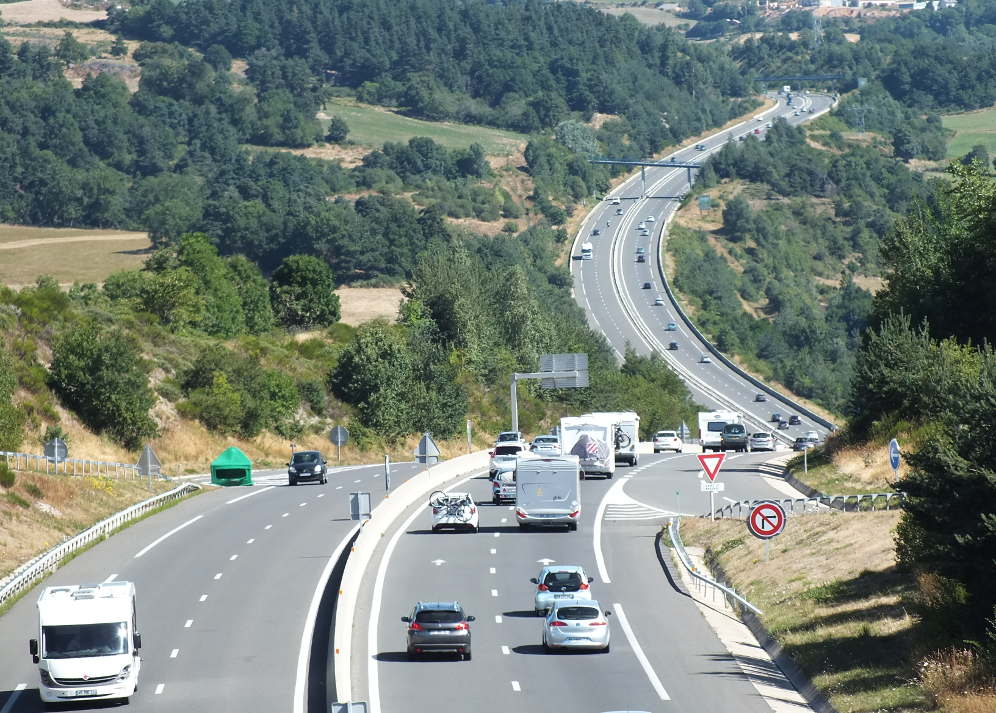

Driving in France & French roadsEssential information for driving in FranceAbout-France.com
- a
thematic guide to France
|
||||||||||||||||
Driving in France - 2018 - mapsbest routes to the south of France Route
maps showing hotels
Routes avoiding
tolls:
Options
using minimal tolls,
|
|
|||||||||||||||
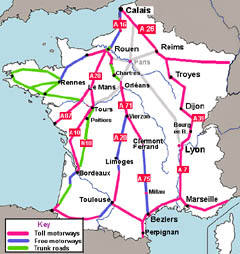 Driving
through France - the main routes for driving to the south or
west : ►
click map for enlargement
and details. Driving
through France - the main routes for driving to the south or
west : ►
click map for enlargement
and details.New speed cameras.Speed cameras on board moving unmarked private cars were introduced in 2017 - starting with Normandy.To keep informed of important driving news for France, follow us on Facebook. About-France.com
- over 200 pages of up-to-date general, cultural, travel and tourist
information about France, written by people who know. All content on
this site is written exclusively for this website .
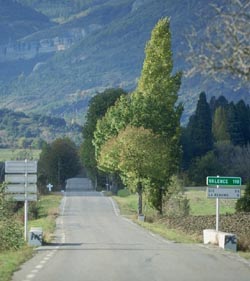 Quiet country roads.... 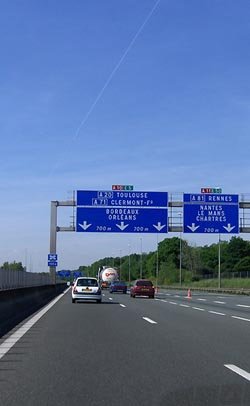 Motorway driving in France is normally quite relaxed... Related pages: Public
holidays in France.
The following days are public holidays ("jours fériés") in France, when all or most shops tend to be shut.
Note that on public holidays, hypermarkets will generally be shut, so unless you have a chip and pin credit card that works in French automatic petrol pumps, you'll need to fill up on the motorway or in normal filling stations. Other
"driving in" pages....
You may also like....
Photo above: Joe Schlabotnik Licence CC. |
MOTORWAYS OR NOT ?► Avoiding problems. When driving in France, in spite of the cost, it is generally worthwhile taking motorways (autoroutes) unless you have time to go at a more leisurely pace. However, there are some useful tips to help you cut down on the cost of your trip across France.a) Petrol (gasolene) (fr. essence): don't fill up on the autoroute! Wait until a major intersection near a town or city, and come off the autoroute. You will almost certainly find a hypermarket / superstore within a kilometer or so of the exit, offering cut price fuel. The saving can be us much as 15 centimes per litre. b) Anyone who intends to do lots of driving in France could find it in their interest to have a diesel car, particularly a modern fuel-efficient model. Diesel fuel in France (often called gasoil, pronounced gaz-warle) used to be about a third cheaper than unleaded, but that is no longer the case; today - 2017 - diesel retails for about 20 centimes a litre less than unleaded, but it also goes further. Very few service stations now stock the old leaded petrol, known as "super". See petrol prices in France below for recent updates. c) Use free autoroutes or dual-carriageways where they exist. See below for details. See below for ideas on avoiding accidents. ► French road signs: Signs indicating a motorway route (whether on the motorway or pointing to it) are indicated with white lettering on a blue background, as in the picture below left. Signs indicating a non-motorway main route (route nationale or other) are indicated with white lettering on a green background, as in  ►FRENCH MOTORWAYS:French motorways, known as autoroutes, are designated with numbers preceded by the letter A (for Autoroute). Thus, when driving to the south of France from Calais, you can either take the A16 autoroute towards Amiens and Paris, or (normally an easier solution) the A26 motorway via Rheims. Most French autoroutes are toll motorways, and entrances to them are marked as such with the word "Péage" (pronounced pay-arje). The normal procedure is to pick up a ticket from a booth as you enter the autoroute (just press the button); tolls are paid either when you leave the autoroute, or else when the toll section comes to an end. In a few places, there are fixed toll points on the autoroute, notably in urban areas or toll bridges. Principal signs on French motorway toll gates:  Three tollgates on a French motorway. Left lane: only for vehicles with the drive-through remote payment transponder (télépéage) - speed limit 30 km/hr Centre lane: for vehicles with the télépéage transponder OR pay by credit card. Right lane: all forms of payment - cards and cash Other signs :
Cash payment toll-gates (green arrow or pictogram of coins) will provide change – even the automatic ones. Frankly, for occasional French motorway users, subscribing to the Liber-T system is a waste of money - unless you think that 20 € a year is worth paying in order to save perhaps a total of 10 minutes at the tolls, or are only travelling at very busy periods. On normal days, you can be through a credit-card payment booth in a minute or less. The "Liber-T" charging sensor is available in the UK, but Sanef, the French motorway operators' company, charges higher rates for users applying via its English language website than for applications from its French website - which can only be used by people having a bank account in France. 2018 Motorway tolls in France -French motorway tolls normally increase more or less in line with inflation each February. French inflatiàon is low, about 1%. The cost of motorway travel for a car without caravan or trailer is about 1 €uro for 10 miles. For example, in Jan 2017 motorway tolls on the 1060 km trip from Calais to Marseille, via Reims, almost all of it on toll motorways, cost 88.2 €uros, about £64. . Here are the toll costs for a selection of other common journeys that use toll motorways over long distances:
The average cost per kilometre depends on what proportion of the journey involves free motorways or other roads. Drivers wanting to avoid French the tolls should remember that it is not necessarily the best solution, particularly in fairly populated areas. Using other roads, with their traffic lights, speed restrictions and roundabouts will mean longer journey times and more stress. ... even if you have a satnav to help you along... Alternatively, check out this low-tolls or no-tolls route to Southwest France and the Spanish border. ► TIP
: Ways to save on motorway tolls when driving to
southwest France
Though it is usually easiest and in the end worth it to take direct motorways and pay the tolls, there is one journey where you can make an appreciable saving for just a few extra kilometres. If driving from Paris to Bordeaux and southwest France, do not follow the A 10 motorway all the way. Leave the A10 at Orleans, following A71 > A20 Toulouse. At Limoges, follow N141 > Angoulême. At Angoulême, follow the N10 for Bordeaux. All but about 60 km. of this alternative route to Bordeaux is on autoroutes or dual carriageway, but after Vierzon, it's all free. Saving: about 36 €uros less in tolls, for a distance of about 15 miles extra.... and cheaper off-motorway petrol if you need it. Alternatively, check this low-tolls or no-tolls route to Southwest France and the Spanish border. Click here for a zoomable detailed road map of France. For more information on French motorway tolls, follow this link to the French motorway network website in English: this site provides a form to fill in, to calculate the cost of a motorway trip through France. For a detailed route, use the route-finder map and distance calculator page on About-France.com. ►Free motorways and routes avoiding tollsThere are a few free motorways in France, and some long-distance dual carriageways that are up to motorway standard. It is even possible to drive right through France avoiding all tolls - though this is not necessarily the best nor the most economical solution. The two links below show our recommended routes to the South of France avoiding most tolls - and alternatives avoiding all tolls.
Among free motorways note in particular
► TRUNK ROADS :These in France are still popularly known as "routes nationales". However, in the framework of "regionalisation", responsibility for most roads has been devolved to local authorities, and the concept of "routes nationales" has largely disappeared. The only "N" roads that now survive are ones that - in the absence of an "autoroute", form part of the strategic national road network, such as the N21 from Limoges to Tarbes, or the N13 from Cherbourg as far as Caen.Road numbering in France"A" roads, such as A71, are motorways, or Autoroutes"N" roads are strategic trunk routes - the National network. "D" roads are roads whose upkeep is paid for by the local Department, or county. They can be anything from busy local routes or former National routes now downgraded, to the quietest of country backroads. When driving in France, it is always best to follow destinations rather than road numbers. Following the regionalisation of responsibility for many roads, the result - if you want to travel by following road numbers - is a classic state of confusion; Drivers following the N13 south from Cherbourg lose it at Caen, as it becomes the D 613 thereafter! From Evreux to Mantes the "N 13" signs reappear, but after that it's the D 113....For another example, anyone wanting to avoid the toll motorway by driving along the old "route nationale" to the southwest corner of France, from Chartres to Biarritz, will follow three disconnected sections of main road known as "N 10"; but in areas where the old N10 is now close to a parallel motorway, the road is now signed as "D 910" or the "D 1010". Some old "N" roads now blithely change their number each time they pass from one department to another !! This is all very confusing for foreign visitors driving in France, but not so much for the French, since with the exception of motorways, they follow a destination, rather than a road number. Destinations via main trunk routes are indicated by the names of towns in white letters on a bright green background, as shown above. 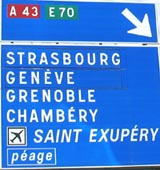 Note that France also displays European
route numbers where appropriate; these are marked with a white number
on a green background, and are in addition to the French road number.
For example the A
6 motorway from Paris to Lyon is also marked as
E15
- E15 being a European route running
from Inverness to Algeciras. Note that France also displays European
route numbers where appropriate; these are marked with a white number
on a green background, and are in addition to the French road number.
For example the A
6 motorway from Paris to Lyon is also marked as
E15
- E15 being a European route running
from Inverness to Algeciras.In the motorway sign on the right, the A43 autoroute is also indicated as being the E70; the main towns it leads towards are indicated in normal lettering; other destinations, such as airports, are indicated in italics. The word "Péage" at the bottom indicates that this is a toll motorway. Click for information on Traffic accidents in France Avoiding main roads in France"Bison Futé" and driving on the byways of France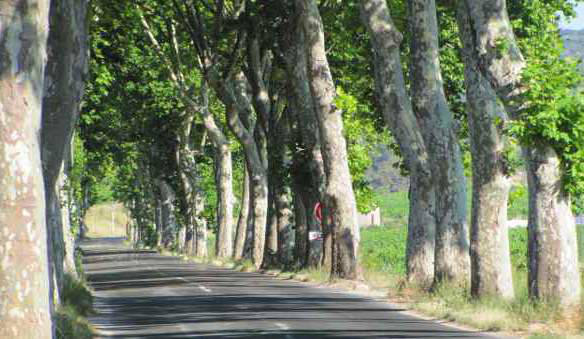 Photo: In bygone times many great "alignements de platanes" - or avenues of plane trees - were planted to give shade to travellers on French roads, specially in the south of France. Though the plane-lined road remains one of the iconic images of France today, few remain, except for short sections on country roads, such as here in Languedoc. "Routes bis"Sometimes you may see direction signs starting with the word Bis, in italics. These are the equivalent of the British "HR" (holiday route) itineraries, using less crowded main roads. Thus a sign saying "bis Lyon" is an alternative route avoiding the main roads, and generally with less lorry traffic. Bis, in French, means second (as in the prefix bi-).The "Bison futé" (in English the cunning bison) is the motorist who does not follow the crowd, but seeks out less crowded easier roads, the "routes bis", thus the "bis-on". If you see a bison futé sign, it will be directing you either to alternative routes themselves or to an information point. On summer Saturdays, being a cunning bison is often well worth it, unless you love driving in heavy traffic or sitting in traffic jams. Driving on the backroads of France requires a good map - or a Satnav that allows you to wander off the beaten track; but in many places, it can still make driving a pleasure, rather than a chore ► Avoiding ParisThis is a good idea on most days. When driving from Calais to the south of France, use the A 26 motorway via Reims, Troyes and Dijon.If driving to south western and central France, avoid Paris going via Rouen, Evreux, Chartres and Orleans. There is no motorway between Evreux and Orleans, but the road over this section is currently being upgraded to dual carriageway, and over half of it is now complete. Avoiding Paris- click for details and route map ► Avoiding peak periods If you can avoid travelling on Saturdays between July 10th and August 30th, this is very advisable. On these days, many French autoroutes - and in particular all the main arteries to the south - are liable to reach saturation. The worst bottlenecks are in the Rhone valley south of Lyons, along the south coast, and around Bordeaux. In January and February, Alpine motorways can get hyper-snarled up with traffic. Check out the busy holiday weeks However, outside these periods, Saturday and Sunday are the best days for driving in France, on motorways and arterial roads. Indeed, on these days, HGV's - lorries or trucks - are banned, meaning that unless you get stuck behind caravans or camper vans, combine harvesters or other various slowdowns, driving is relatively hassle-free. Night driving in FranceDriving between the hours of 8 p.m and 6 a.m. can be a good way to avoid the traffic. Motorway driving can be considerably easier at night during peak holiday travel periods. Leaving Calais at 6 p.m., you can be almost half way down France by midnight. Depending on the route you take, you can book a hotel near the motorway near Tours (A10 route) or Bourges (A71 route) or Dijon (A26 route)However it is vital to ensure that you have had sufficiient rest or sleep in the day before setting out on an overnight journey. Cars from the UK and Ireland must have headlight dip deflectors if driving after dark ►HGV restrictions in France
See themed page : HGV information for France
► Petrol (Gas) stations in FranceAlmost all petrol stations in France accept Visa and Mastercard; however take care with 24h automatic pumps in supermarket forecourts. Many of these do not accept credit cards without integrated chip and PIN number. Most UK cards now have integrated chip and pin, so the times when UK cards did not work in French petrol stations are now history for most travellers. However, if you think you may need to fill up in an emergency while driving in France, check your card out at a supermarket self-service pump well before you run out. If it doesn't work, nip round and join the queue for the pay-at-the counter pumps. Make sure that you don't have to fill up in an emergency using an untested card at an unmanned filling station at night or on Sundays.France Fuel price watch:Compared to the UK, there is not a big difference, except for diesel which is much cheaper (about 15%) in France. In early August 2017 typical supermarket fuel prices in France were :
E10 graded fuels (containing 10% of ethanol bio-fuel) are a couple of centimes cheaper, where they are available. These are compatible with most modern cars; if in doubt check with your supplier. (There are 3.79 litres to 1 US gallon; but generally speaking cars in Europe are smaller and consume less fuel than cars in the USA.) Click for information on Traffic accidents in France ► Overnight stops.Motorway hotels or something else? France is very well equipped in hotels and other types of accommodation. Many of the chains , such as Novotel (3 stars) , Mercure (3 stars), Ibis (2 stars) , Ibis budget (2 stars), and Formule 1 (1 star), have outlets clustered near motorway exits, notably near the exits from toll motorways and around towns and cities. The hotel links below list only the French motorway hotels that are really easy to find.Find and book an overnight stop
....
► Click here for hotels beside motorways to west and southwest France. ► Click here for hotels beside motorways to east and southeast France. ► For quiet B&B accommodation, check out the B-and-B in France website. Stop to shop... See the French shopping guide page for useful information if you are planning to stop to shop on your way back home...
|
DRIVING IN FRANCEGet
the app !
France driving info app now available for FREE for android phones and
tablets from Google Play storeDownload now Choose where to stay in rural
France
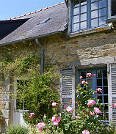 French gite and B&B locator maps Book directly in English with the owners Gitelink.com Find
hotels
in France
 Reims Dijon Beaune Lyon Rouen Orleans Tours Limoges Poitiers Bordeaux Clermont-Fd. About-France.com
is
partnered with Europe's leading hotel booking portal, Booking.com>,
to
bring you the best online prices
Copyright notice: Website
and text © About-France.com
2003 - 2019 except
where otherwise
indicated.
To contact About-France.com, please use our contact form : We are sorry but About-France.com cannot answer questions about individual travel plans. |
|||||||||||||||||||||||||||||||||||||||||||||||||||








 Find us on
Find us on